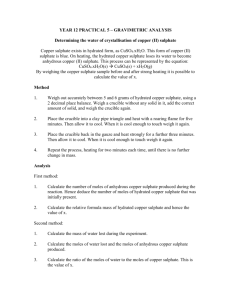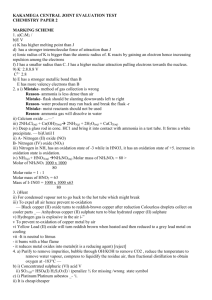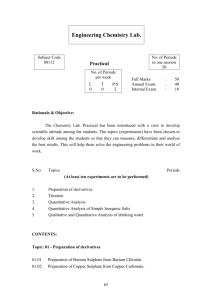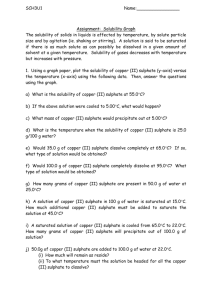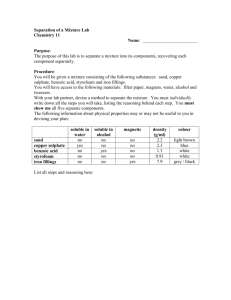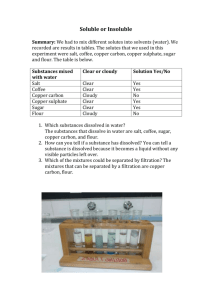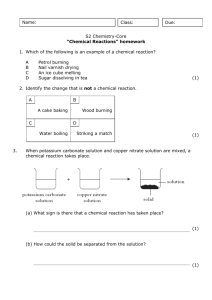Sample lab report
advertisement
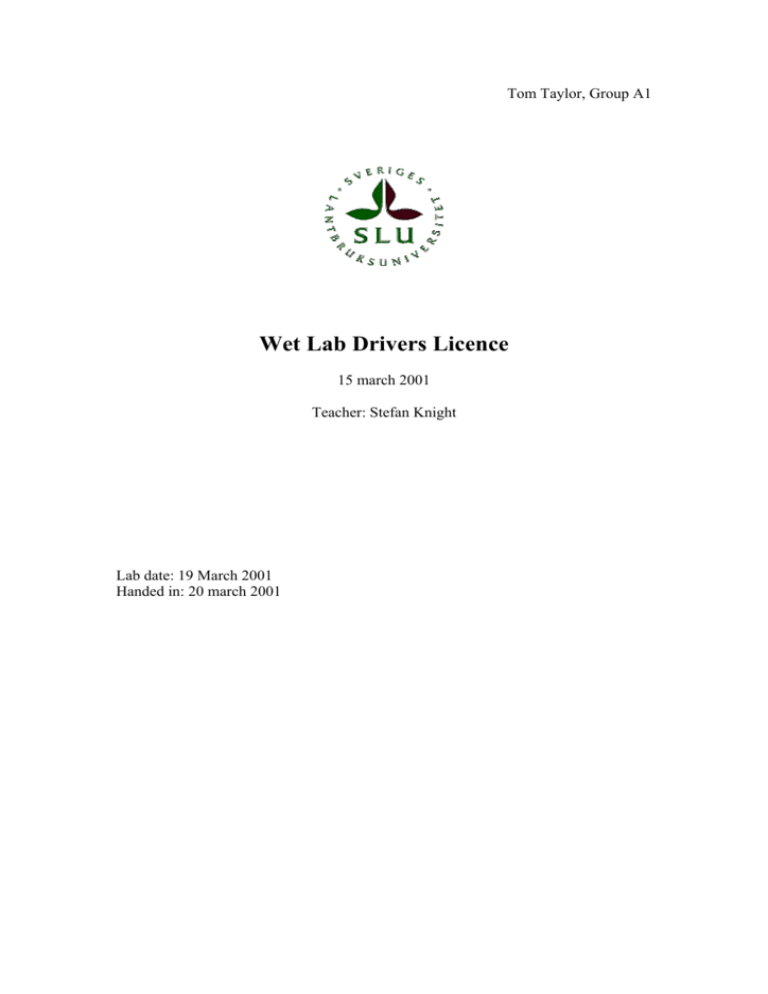
Tom Taylor, Group A1 Wet Lab Drivers Licence 15 march 2001 Teacher: Stefan Knight Lab date: 19 March 2001 Handed in: 20 march 2001 Abstract The purpose of this experiment were two-fold. Firstly, the experiment served as an introduction to the laboratory equipment and safety procedures. Secondly, we were to measure the extinction coefficient of copper sulphate at 600 nm by spectrophotometry. We also estimated the error made whilst pipetting the solutions, and this error was not allowed to exceed 5%. The extinction coefficient we measured was 0.942 M-1 cm-1, and the error we observed in pipetting was 2.0%, well within the allowed error margin. Introduction Some solutions absorb light at certain visible wavelengths more than others. This property gives the solution a colour which can be observed by the eye. Copper sulphate is blue in solution, since the Cu2+ ions absorb the red (longer wavelength) light which pass through. The amount of light absorbed is proportional to the concentration of the solution, and the path length through which the light passes. This is shown by the Lambert-Beer law: A=ε*c*l where A is the absorbance, c the concentration (in molar), l the length in cm, and ε is a constant, known as the molar extinction coefficient. In order to measure absorbance, a spectrophotometer is used. The spectrophotometer can be set to a precise light wavelength, for example 600 nm for red light, and zeroed using a solution which does not absorb at the wavelength of interest, for example water. To measure the absorbance of a coloured solution, the solution is first transferred into a cuvette in which the path length (l) is known precisely. The cuvettes we used were 1 cm in length. Plastic cuvettes are OK when measuring using visible light, but for measuring at UV wavelengths, special quartz glass cuvettes are required. The extinction coefficient for a certain solution can be determined as follows. Using a solution of known concentration, a series of known dilutions is made and the absorbance measured. A plot of absorbance vs. concentration (in molar) gives a straight line whose equation is given by the Lambert-Beer law. The slope of the line is the molar extinction coefficient. The reason for taking many measurements rather than just one is to reduce the possible errors in dilution and measurement. Methods Materials 0.345 M CuSO4 Pipettes and pipette tips Plastic cuvette Spectrophotometer Methods The experiment was performed according to the instructions given in the lab instructions [1]. From the 0.345 M stock solution we made 10 dilutions by taking 0.1 ml, 0.2 ml, 0.3 ml, ..., 1ml and then making the total volume up to 1 ml using deionised water. For volumes greater than 0.2 ml, a 1000 µl pipette was used, and for volumes less than this a 200 µl pipette. The absorbance of each solution was measured in a plastic cuvette with 1 cm path length using a spectrophotometer at a wavelength of 600 nm. The spectrophotometer was first zeroed at this wavelength using a water blank. Results The results of our experiment are shown in Table 1 and the values shown plotted in Figure 1. The absorbance of the solutions increase linearly with the amount of copper sulphate added, corresponding to increasing volumes of the stock copper sulphate solution added. A linear regression line was calculated from the data series using Excel. Comparing this with the data series, one point corresponding to 0.6 ml added copper sulphate appears to be the most inaccurate. The calculations of the molar extinction coefficient for copper sulphate and the residual error are shown below. Table 1. The measured absorbances Abs(obs), calculated absorbances Abs(calc) based on the line of best fit, and absolute difference for the copper sulphate dilution series. Tube 11 corresponds to 0.345 M copper sulphate. Tube 1 2 3 4 5 6 7 8 9 10 11 Total ml H2O 1.0 0.9 0.8 0.7 0.6 0.5 0.4 0.3 0.2 0.1 0.0 ml CuSO4 0.0 0.1 0.2 0.3 0.4 0.5 0.6 0.7 0.8 0.9 1.0 Abs(obs) 0.000 0.038 0.069 0.103 0.135 0.169 0.189 0.227 0.260 0.291 0.327 1.808 Abs(calc) 0.000 0.032 0.065 0.098 0.130 0.163 0.196 0.228 0.260 0.293 0.326 |Abs(obs)-Abs(calc)| 0.000 0.006 0.004 0.005 0.005 0.006 0.007 0.001 0.000 0.002 0.001 0.037 0.35 0.3 Abs. 600 nm 0.25 0.2 0.15 0.1 0.05 0 0 0.1 0.2 0.3 0.4 0.5 0.6 0.7 0.8 0.9 1 Vol copper sulphate (ml) Figure 1. Plot of measured absorbance at 600 nm versus voulme copper sulphate From the above data, the molar extinction coefficient for copper sulphate at 600 nm can be calculated as follows: Gradient of line = 0.325 cm-1 (ml CuSO4)-1 1 ml CuSO4 corresponds to 0.345 M ε600 (CuSO4) = 0.325/0.345 = 0.942 M-1 cm-1 The residual (random error) is: Σ(|Abs(calc)-Abs(obs)|)/Σ(Abs(obs)) = 0.037/1.808 = 0.02 (2%) Discussion Spectrophotometry The goal of this experiment was to become acquainted with the laboratory and safety aspects, and to obtain some basic experience in using the pipettes and spectrophotometers by measuring the molar extinction coefficient for copper sulphate. We obtained a value for the molar extinction coefficient at 600 nm for copper sulphate of 0.942 M-1 cm-1. From our results, we calculated a random error of 2%. These errors are due to many factors, but the main reason is inconsistency in pipetting the solutions. An error less than 5% was acceptable for this experiment. Other sources of errors are avoidable. The cuvette should be clean (we were careful not to touch the transparent sides), and always placed in the spectrophotometer in the same direction. Bubbles in the solution should be avoided since they also scatter light. We removed small bubbles by tapping the cuvette on the lab bench. It is also not a good idea to measure absorbances which are less than 0.01 or greater than 2, since these values correspond to 99% and 1% transmittance respectively of the original light beam. Most spectrophotometers have a sensitivity of this order, so the error in measurement is large. We measured a series of concentrations, so we proceeded from the lowest to the highest concentration. This minimises the error due to residual solution left in the cuvette from the previous measurement. Ideally, the cuvette should be cleaned between each measurement. Lab Safety Before the experiment, we had a talk about safety procedures in the lab. These are outlined in the lab instructions [1]. References [1] Lab 1 instructions, Bke1 Course Compendium VT 2000.

